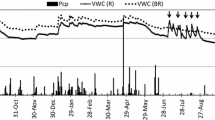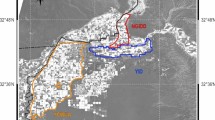Abstract
Crop evapotranspiration (ETc) and crop coefficient (K c) for drip-irrigated bell pepper grown on plastic-mulched beds for climatically different growing seasons were quantified using drainage lysimeters located in the Southwest Florida. We tested whether: (1) the literature K c (with climatic adjustment) yields accurate ETc estimates; (2) K c values are applicable across the growing seasons that are climatically different; and (3) a thermal-based generic model can be developed to accurately predict K c for gradually cooling (fall) and warming (spring) seasons. Spring ETc (229 mm) was statistically (p = 0.03) higher than fall (189 mm). Seasonal K c values were also statistically different, and average fall value (0.86) was 20 % higher than spring (0.72), confirming K c’s seasonality. The K c values for the fall were statistically higher than FAO-56 K c’s which underestimated ETc by 22 %. Use of fall K c overestimated spring ETc by 24 %, while it was 12 % underestimation for the opposite. These errors were 16–69 % of rainfall and 26–46 % of farm-scale surface flows highlighting the need for accurate ETc predictions. The seasonal differences in K c could be accurately predicted with a generic growing degree days (GDD) model (r 2 = 0.95). The results not only provide an improved ETc estimate for plastic-mulched pepper in the study area, but also for other regions using the GDD-based model that utilize readily available temperature data. The GDD model can be further improved using additional data in future.





Similar content being viewed by others
References
Aboukhaled A, Alfaro A, Smith M (1982) FAO irrigation and drainage paper 39. Food and Agriculture Organization of United Nations, Rome
Agam N, Evett SR, Tolk JA, Kustas WP, Colaizzi PD, Alfieri JG, McKee LG, Copeland KS, Howell TA, Chavez JL (2012) Evaporative loss from irrigated interrows in a highly advective semi-arid agricultural area. Adv Water Res 50:20–30
Allen RG (2000) Using the FAO-56 dual crop coefficient method over an irrigated region as part of an evapotranspiration intercomparison study. J Hydrol 229(1–2):27–41
Allen RG, Smith M, Perrier A, Pereira LS (1994) An update for the definition of reference evapotranspiration. ICID Bull 43(2):1–34
Allen RG, Pereira LS, Raes D, Smith M (1998) Crop evapotranspiration. Guidelines for computing crop water requirements. FAO Irrigation and Drainage paper 56. Rome, Italy. Food and Agriculture Organization of United Nations
Allen RG, Pereira LS, Smith M, Raes D, Wright J (2005) FAO-56 dual crop coefficient method for estimating evaporation from soil and application extensions. J Irrig Drain Eng 131(1):2–13
Allen RG, Pereira LS, Howell TA, Jensen ME (2011) Evapotranspiration information reporting: I. Factors governing accuracy. Agric Water Manage 98(6):899–920
Amayreh J, Al-Abed N (2005) Developing crop coefficients for field-grown tomato (Lycopersicon esculentum Mill.) under drip irrigation with black plastic mulch. Agric Water Manag 73(3):247–254
Brown PW, Charles FM, Young MH, Thompson TL, Wierenga PJ, Kopec DM (2001) Penman Monteith crop coefficients for use with desert turf systems. Crop Sci 41(4):1197–1206
Bryla DR, Trout TJ, Ayars JE (2010) Weighing lysimeters for developing crop coefficients and efficient irrigation practices for vegetable crops. HortScience 45(11):1597–1604
Buytaert W, Beven K (2009) Regionalization as a learning process. Water Resour Res 45:W11419. doi:10.1029/2008WR007359
Carlisle VW, Sodek F, Collins ME, Hammond LC, Harris WG (1989) Characterization data for selected Florida soils. Soil Sci Res Report No 89-1, Soil and Water Science Dept., University of Florida, Gainesville
Cooley H, Christian-Smith J, Gleick PH (2009) Sustaining California agriculture in an uncertain future. Pacific Institute, Oakland
Csizinszky AA, Schuster DJ, Kring JB (1995) Color mulches influence yield and insect pest population in tomatoes. J Am Soc Hortic Sci 120(5):778–784
De Swart EAM, Marcelis LFM, Voorrips RE (2006) Variation in relative growth rate and growth traits in wild and cultivated Capsicum accessions grown under different temperatures. J Hortic Sci Biotechnol 81:1029–1037
Ding R, Kang S, Zhang Y, Hao X, Tong L, Du T (2013) Partitioning evapotranspiration into soil evaporation and transpiration using a modified dual crop coefficient model in irrigated maize field with ground-mulching. Agric Water Manag 127:85–96
Duchemin B, Hadria R, Erraki S, Boulet G, Maisongrande P, Chehbouni A, Escadafal R, Ezzahar J, Hoedjes JCB, Kharrou MH, Khabba S, Mougenot B, Olioso A, Rodriguez JC, Simonneaux V (2006) Monitoring wheat phenology and irrigation in Central Morocco: on the use of relationships between evapotranspiration, crop coefficients, leaf area index and remotely-sensed vegetation indices. Agric Water Manag 79:1–27
Erickson AN, Markhart AH (2001) Flower production, fruit set, and physiology of bell pepper during elevated temperature and vapor pressure deficit. J Am Soc Hortic Sci 126(6):697–702
Farahani HJ, Oweis TY, Izzi G (2008) Crop coefficient for drip irrigated cotton in a Mediterranean environment. Irrig Sci 26(5):375–383
Irmak S (2005) Crop evapotranspiration and crop coefficients of viburnum Odoratissimum (Ker-gawl). Appl Eng Agric 21(3):371–381
Irmak S, Kabenge I, Rudnick D, Knezevic S, Woodward D, Moravek M (2013) Evapotranspiration crop coefficients for mixed riparian plant community and transpiration crop coefficients for Common reed, Cottonwood and Peach-leaf willow in the Platte River Basin, Nebraska-USA. J Hydrol 481:177–190
Jaber FH, Shukla S (2012) MIKE SHE: model use, calibration and validation. Trans ASABE 55(4):1479–1489
Jensen ME (ed) (1973) Consumptive use of water and irrigation water requirements. ASCE Technical Committee Report. ASCE, New York
Jensen ME, Burman RD, Allen RG (1990) Evapotranspiration and irrigation water requirements. ASCE Manuals and Report on Engineering Practice, no. 70. ASCE, New York
Kang S, Gu B, Du T, Zhang J (2003) Crop coefficient and ratio of transpiration to evapotranspiration of winter wheat and maize in a semi humid region. Agric Water Manag 59(1):239–254
Kar G, Verma HN (2005) Phenology based irrigation scheduling and determination of crop coefficient of winter maize rice fallow of eastern India. Agric Water Manag 75:169–183
Liu Y, Luo Y (2010) A consolidated evaluation of the FAO-56 dual crop coefficient approach using the lysimeter data in the North Chain Plain. Agric Water Manag 97(1):31–40
Liu C, Zhang X, Zhang Y (2002) Determination of daily evaporation and evapotranspiration of winter wheat and maize by large-scale weighing lysimeter and micro-lysimeter. Agric Forest Meteorol 111(2):109–120
Liudahl K, Belz DJ, Carey L, Drew RW, Fisher S, Pate R (1998) Soil survey of Collier County area, Florida. US Department of Agriculture and Natural Resources Conservation Service. http://www.nrcs.usda.gov. Accessed 7 June 2013
Lovelli S, Pizza S, Caponio T, Rivelli AR, Perniola M (2005) Lysimetric determination of muskmelon crop coefficients cultivated under plastic mulches. Agric Water Manag 72(2):147–159
Martinez-Cob A (2008) Use of thermal units to estimate corn crop coefficient under semiarid climatic conditions. Irrig Sci 26:335–345
McMaster GS, Wilhelm WW (1997) Growing degree-days: one equation, two interpretations. Agric Forest Meteorol 87:291–300
Miles C, Kolker K, Reed J, Becker G (2005) Alternative to plastic Mulch for organic vegetable production. Report of The Washington State University. http://agsyst.wsu.edu/AlternativeMulchReport05.pdf. Accessed 21 August 2013
Moratiel R, Martinez-Cob A (2011) Evapotranspiration of grapevine trained to a gable trellis system under netting and black plastic mulching. Irrig Sci 30:167–178
Mukherjee A, Kundu M, Sarkar S (2010) Role of irrigation and mulch on yield, evapotranspiration rate and water use pattern of tomato (Lycopersicon esculentum L.). Agric Water Manag 98:182–189
Mutiibwa D, Irmak S (2013) AVHRR-NDVI-based crop coefficients for analyzing long-term trends in evapotranspiration in relation to changing climate in the US high plains. Water Resour Res 49:231–244. doi:10.1029/2012WR012591
Nielsen DC, Hinkle SE (1996) Field evaluation of basal crop coefficients for corn based on growing degree-days, growth stage, or time. Trans ASAE 39:97–103
Orgaz F, Fernandez MD, Bonachela S, Gallardo M, Fereres E (2005) Evapotranspiration of horticultural crops in an unheated plastic greenhouse. Agric Water Manag 72(2):81–96
Payero J, Irmak S (2013) Daily energy fluxes, evaporation and crop coefficient of soybean. Agric Water Manag 129:31–43
Ritchie JT, NeSmith DS (1991) Temperature and crop development. In: Hanks J, Ritchie JT (eds), Modeling plant and soil systems, agronomy monograph No. 31. ASA, CSSA, and SSSA, Madison, WI, pp 5–29
Rosenberg NJ, Blad BL, Verma SB (1983) Microclimate: the biological environment. Wiley, New York
Sammis TW, Mapel CL, Lugg DG, Lansford RR, McGuckin JT (1985) Evapotranspiration crop coefficients predicted using growing degree days. Trans ASAE 28(3):773–780
SFWMD (2013) Basis of review for water use. http://www.sfwmd.gov. Accessed 24 July 2014
Shinde D, Mansell RS, Hornsby AG, Savabi MR (2001) The hydro-thermal environment in plastic-mulched soil beds: modeling analysis. Proc Soil Crop Sci Soc Fla 60:64–71
Shrestha NK, Shukla S (2014) Basal crop coefficient for vine and erect crops with plastic mulch in a sub-tropical Florida. Agric Water Manag 143:29–37
Shrestha NK, Shukla S (2015) Support vector machine based modeling of evapotranspiration using hydro-climatic variables in a sub-tropical environment. Agric Forest Meterol 200:172–184
Shukla S, Srivastava S, Hardin JD (2006) Design, construction, and installation of large drainage lysimeters for water quantity and quality studies. Appl Eng Agric 22(4):529–540
Shukla S, Boman BJ, Ebel RC, Roberts PD, Hanlon EA (2010) Reducing unavoidable nutrient losses from Florida’s horticultural crops. HortTechnology 20(1):52–66
Shukla S, Shrestha NK, Goswami D (2014a) Evapotranspiration and crop coefficients for seepage-irrigated watermelon with plastic mulch in a sub-tropical region. Trans ASABE 57(4):1017–1028
Shukla S, Shrestha NK, Jaber FH, Srivastava S, Obreza TA, Boman BJ (2014b) Evapotraspiration and crop coefficient for watermelon grown under plastic mulched conditions in sub-tropical Florida. Agric Water Manag 132:1–9
Singandhupe RB, Sethi RR, Katti GS (2005) Estimation of reliable evapotranspiration model and crop coefficient in red gram (Cajanus cajan L.) for semi-arid environments in India. Arch Agron Sci 51(4):433–445
Southeast Regional Climate Center (2010). Monthly climate summary, Immokalee, Florida. http://www.sercc.com. Accessed 21 Aug 2013
Tasumi M, Allen RG, Trezza R, Wright JL (2005) Satellite-based energy balance to assess within-population variance of crop coefficient curves. J Irrig Drain Eng 131(1):94–109
Valiantzas JD (2013) Simplified forms of the standardized FAO-56 Penman–Monteith reference evapotranspiration using limited weather data. J Hydrol 505:13–23
Valipour M (2014) Comparative evaluation of radiation-based methods for estimation of potential evapotranspiration. J Hydrol Eng. doi:10.1061/(ASCE)HE.1943-5584.0001066
Vázquez RF, Feyen J (2003) Effect of potential evapotranspiration estimates on effective parameters and performance of the MIKE SHE-code applied to a medium-size catchment. J Hydrol 270(3–4):309–327
Williams LE, Ayars JE (2005) Grapevine water use and the crop coefficient are linear function of the shaded area measured beneath the canopy. Agric Forest Meterol 132:201–211
Zhou L, Zhou G (2009) Measurement and modeling of evapotranspiration over a reed (Phragmites australis) marsh in Northeast China. J Hydrol 372(1–4):41–47
Author information
Authors and Affiliations
Corresponding author
Additional information
Communicated by S. Ortega-Farias.
Rights and permissions
About this article
Cite this article
Shukla, S., Shrestha, N.K. Evapotranspiration for plastic-mulched production system for gradually cooling and warming seasons: measurements and modeling. Irrig Sci 33, 387–397 (2015). https://doi.org/10.1007/s00271-015-0473-5
Received:
Accepted:
Published:
Issue Date:
DOI: https://doi.org/10.1007/s00271-015-0473-5




